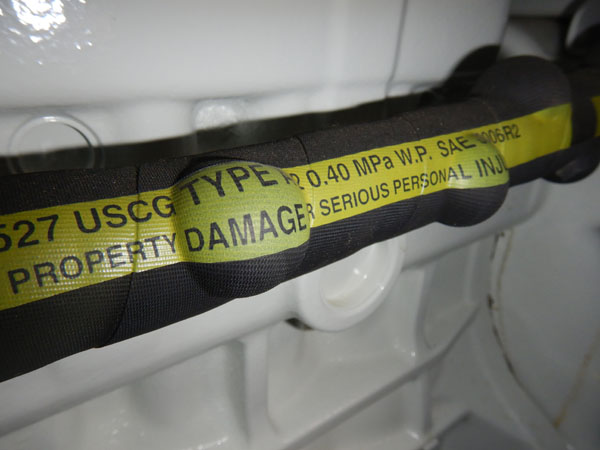Photo Essay: Closed Cooling System Hose Failure
While both must be reliable and robust, hoses used for conveying coolant (often incorrectly referred to as anti-freeze) as opposed to those that are used for raw or seawater, must be capable of enduring exposure to 200° Fahrenheit liquid, as well as pressure as high as 15 psi. In most cases, hoses that carry an SAE J2006 “Marine Wet Exhaust” rating, can be used with confidence in either application. There is no hard and fast rule for closed cooling system hose replacement, however, they should be inspected regularly for signs of cracking or permeation; in the latter case coolant is forced through the hose skin in small quantities, dries and leaves behind a white powdery residue, which can be an indication of a restriction downstream of that hose.
In the example shown here, the hose used on this genset, which is original equipment, has developed blister-like bumps, the origin of which are unknown. It is located on the far, or non-service side, of the genset, making this phenomenon more difficult to notice. Therefore, it’s important to inspect all hoses, including those that cannot be seen, on engines and gensets. Any signs of cracking, checking, brittleness or other deterioration are grounds for replacement. Barring that, the reliable service life for high quality (not all are) coolant hoses is about six to eight years, if it’s been that long since yours have been replaced, they don’t owe you anything, go ahead and swap them out for new ones. When doing so, carefully inspect clamps for signs of corrosion and cracks.
Ask Steve
Hi Steve,
It’s Captain Pete from seaangelcharters in Toronto, Canada.
I have a problem with an 89 Crusader 454, dirty grey smoke is coming out of the exhaust. Temps are ok, around 175 degrees and don’t burn any oil. The grey smoke is more noticeable over 2000 rpms.
The boat has around 4,000 hours and has mostly been used for trolling.
I would appreciate any advice.
Pete Petropanagos
Pete:
First, if this 30+ year old power plant genuinely has 4000 original hours on the clock, and it’s never been torn down or had the heads off, that’s extraordinary for a marine gasoline engine. I’m not sure it owes you anything at this point.
Having said that, does it turn up to the full rated wide open throttle RPM? If not, that needs to be resolved, and I’d check the compression while you are at it. If you’ve trolled a lot the rings may be carbon-fouled.
Assuming that checks out OK, gray smoke can be caused by improperly adjusted valves, an out of tune carburetor (I’m assuming it’s carbureted for the age), worn/incorrectly gapped spark plugs, or incorrect timing. All of those are relatively easy to check and correct.
Hi Steve,
First, thank you for the expertise you offer to us oftentimes naive boaters. You are probably saving lives with the knowledge you impart to us through your articles.
Could you clarify something I wondered about while reading a recent article of yours Cruising World. Should metal through hull fittings be bonded? If yes, does the size of the wire still need to conform to the size requirements of grounded wires your article referred to? Or can the bonding wire size be much smaller since it is not expected to carry the amperage of the boat’s electrical system?
Bob Storrar
Bob:
The subject of bonding is almost as controversial as that of anchor selection. While American Boat and Yacht Council Standards include a chapter on the subject, E-2, Cathodic Bonding system, bonding is considered optional. Having said that, for a variety of reasons, including the mitigation of galvanic and stray current corrosion, lightning strike mitigation and electrocution prevention, I’m a bonding advocate.
Per E-2, “Cathodic bonding conductors shall be oil resistant, insulated, tinned, stranded copper wire, or uninsulated copper strip. Copper braid or copper tubing shall not be used for this purpose.” The Standards go on to dictate that wire, where used for cathodic bonding systems, must be a minimum of #8 AWG.
For more on the subject see here.
Hi Steve,
I’ve discovered you through Attainable Adventure & John Harries, thanks for all you do to demystify so many subjects from diesels to galvanic corrosion.
In your articles, you seem to make a concerted effort to not support or recommend particular products. Case in point is the Reference Cell Testing article where you say “A silver/silver chloride reference electrode. Quality varies, so choose carefully and if the price seems too good to be true, it probably is.”
So where do we find them? I spent hours looking around and avoided Amazon, found boatzincs.com and they have a really good one, and a great guide on how to use it. Saving the reader the trouble and hassle of getting the wrong thing would be a service.
Just wondering why you avoid that?
Tim:
Thanks for the note and query. On the contrary, I’m scrupulous about naming names under the right conditions. Unlike other marine journalists who mention products because they received them for free, or because they are advertisers in the magazines for which they write, or because someone they interviewed told them about it, I only name products I’ve used personally. I recently wrote a soon to be published article for Cruising World, detailing my favorite lubricants, rust inhibitors and conductants/dielectrics, naming names.
The reference cell I use was purchased from Mercury Marine about 30 years ago, they were among the early leaders in the marine industry on corrosion analysis and control. They provided one of the very first true galvanic isolators as well. I’m not sure if they even sell the reference cell anymore, and in any event, you’d have to order it from a Mercury Marine dealer, which isn’t convenient for most.
Corrosion analysis colleagues tell me they have used the BoatZincs reference cell with success, so I think you’d be fine going that route.



